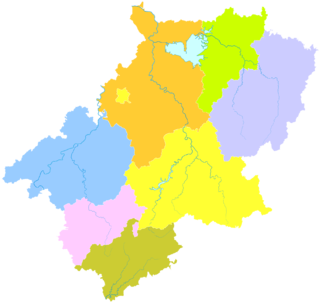
Anhui is a province of the People's Republic of China located in the eastern region of the country. The province is located across the basins of the Yangtze River and the Huai River, bordering Jiangsu to the east, Zhejiang to the southeast, Jiangxi to the south, Hubei to the southwest, Henan to the northwest, and Shandong for a short section in the north.

Xidi is a village in Xidi Town (西递镇), Yi County, Huangshan City of the historical Huizhou region of Anhui province, China. It was declared a part of the "Ancient Villages in Southern Anhui" World Heritage Site by UNESCO in 2000, along with Hongcun.

Hongcun is a village in Hongcun Town, Yi County, Huangshan City in the historical Huizhou region of southern Anhui Province, China, near the southwest slope of Mount Huangshan.
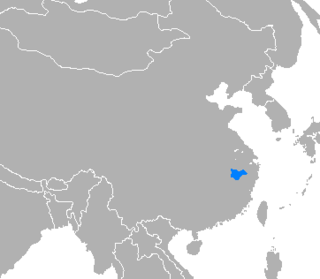
Huizhou or Hui, is a group of closely related varieties of Chinese spoken over a small area in and around the historical region of Huizhou, in about ten or so mountainous counties in southern Anhui, plus a few more in neighbouring Zhejiang and Jiangxi.
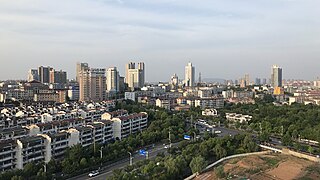
Xuancheng is a city in the southeast of Anhui province. Founded in 109 BCE, Xuancheng has over 2,000 years of history. Located in the lower Yangtze River drainage basin and Yangtze River Delta, it borders Wuhu to the northwest, Chizhou to the west, Huangshan to the southwest, and the provinces of Zhejiang and Jiangsu to the southeast and northeast respectively.
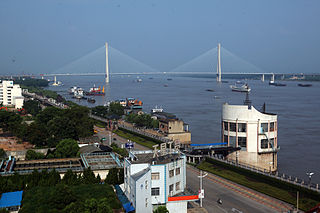
Anqing is a prefecture-level city in the southwest of Anhui province, People's Republic of China. Its population was 5,311,579 at the 2010 census, with 780,514 living in the built-up area.
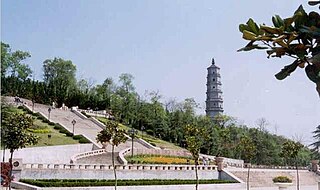
Chizhou is a prefecture-level city in the south of Anhui province, China. It borders Anqing to the northwest, Tongling and Wuhu to the northeast, Xuancheng to the east, Huangshan to the southeast, and the province of Jiangxi to the southwest.
Huizhou District is a district of Huangshan City, Anhui province, People's Republic of China. It has a population of 100,000 and an area of 424 square kilometres (164 sq mi). It was carved out from Shexian County (歙县) after the 1987 renaming of the entire region from Huizhou to Huangshan City.

She County, or Shexian, is a county in the southeast of Anhui Province, China, bordering Zhejiang Province to the east. It is the easternmost county-level division of the prefecture-level city of Huangshan City. It has a population of 500,000 and an area of 2,236 square kilometres (863 sq mi).
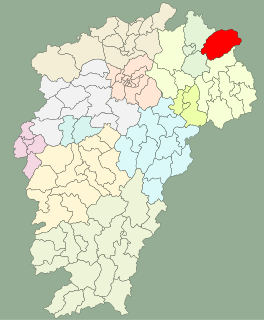
Wuyuan County is a county in the northeast of Jiangxi province, People's Republic of China, bordering the provinces of Zhejiang to the east and Anhui to the north. It is under the jurisdiction of the prefecture-level city of Shangrao.

Tongshan District, formerly Tongshan County is one of six districts of Xuzhou, Jiangsu province, People's Republic of China, bordering Anhui and Shandong provinces.

Hui opera, or Huiju, is a regional genre of Chinese opera originally from southern Anhui. It is popular in the area around Huangshan City and Chizhou, as well as Wuyuan County, Jiangxi, and was formerly also popular in neighboring Zhejiang. It has existed for over 300 years.

Hangzhou–Huangshan intercity railway or Hanghuang ICR is a dual-track, electrified, high-speed rail line between Hangzhou, Zhejiang and Huangshan, Anhui. The line runs 265 km (165 mi) through northwestern Zhejiang and southern Anhui and accommodates trains traveling at speeds up to 250 km/h (160 mph). Travel time from Hangzhou to Huangshan was reduced to about one and one-half hour. The line is the first rail link between the two cities and brings counties in mountainous southern Anhui closer to the Yangtze River Delta region. Construction began on June 30, 2014, and the line opened on December 25, 2018.

Doushan Street is a historical residential street in She County, Anhui province, China. It is named after a neighboring hill called Dou Hill by locals and is a noted tourist attraction in the area.
The Wang Hanzhou residence, built in the late Qing dynasty, is located at 83, Hebei Avenue in the New River area. The wood building is in the traditional Chinese courtyard style and open on three sides. Built of brick with dimensions of 42 by 12 metres, the structure has a courtyard, atrium, and dwelling rooms. Ornate, high relief wood carvings were made in the doors and beams of the house in the designs of birds, figures, and flowers. A half-moon shaped hall is situated on the top floor of the three stories. The residence has views of the pier and the New River. It is considered a masterpiece of residential architecture in Nanjing.
Jiang Shan is a Chinese politician who spent most of his career in East China's Anhui province. As of April 2014 he was under investigation by the Communist Party's anti-corruption agency, and he was expelled from the party and removed from office in December 2014. Previously he served as the Communist Party Secretary of Chuzhou.

Chinese regional cuisines are the different cuisines found in different provinces and prefectures of China as well as from larger Chinese communities overseas.
Hwiju Yo clan was one of the Korean clans. Their Bon-gwan was in Huizhou District, Huangshan City, Anhui, China. According to the research in 1985, the number of Hwiju Yo clan was 274. The name of Hwiju Yo clan came from China. According to the census in 1930, 10 families belonged to Hwiju Yo clan. But it has been found that 6 out of the 10 families living in North Hamgyong Province were descendants in Ming dynasty and were naturalized to Joseon to avoid conflicts happened more than 290 years before.



